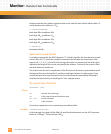
Monitor: PmT1 and PmE1-Specific Functions
PmT1 and PmE1 User’s Manual 10002367-02
8-32
Description: This is a collection of miscellaneous board support functions.
The functions MemTop and MemBase are used to determine the addresses of the last and
first long words in free memory. The size of DRAM is determined by the configuration regis-
ter. The base of free memory is determined by the compiler-created variable End, which
indicates the end of the monitor’s bss section.
The time_delay function provides a fixed delay for timing. As a delay generator, this func-
tion can be used to delay in increments of microseconds as specified by the MicroSec argu-
ment.
The IsPowerUp function determines if a power-up or reset just occurred.
The SetNotPowerUp function resets the power-up register.
NvHkOffset
NvHkOffset()
NvMonOffset()
NvMonSize()
NvMonAddr()
Description: These functions allow the nonvolatile library functions to operate on the nonvolatile mem-
ory sections without actually compiling the board configuration files into the library.
The NvHkOffset and NvMonOffset functions describe where in the nonvolatile memory
device the Emerson- and monitor-defined data sections begin. In general, the Emerson-
defined data section and the monitor data section reside in the user-writeable section of
the nonvolatile memory device. The returned value is the offset in bytes from the begin-
ning of the device in which the section is loaded.
The functions NvMonSize and NvMonAddr return the size and location of the nonvolatile
monitor configuration data structure. This again allows other monitor facilities and applica-
tion programs to get at the monitor configuration structure without having to know too
much about the monitor.
NvRamAcc
unsigned char NVRamAcc(Mode, Cnt, Val)
unsigned long Mode, Cnt;
unsigned char Val;
Description: NVRamAcc function provides access to the lower level utilities of the X24C16 device. The
Mode indicates one of four access types: READ, READ_PROBE, WRITE, and WRITE_PROBE.
If Mode is zero, a byte is read from nonvolatile memory. If Mode is one, a byte is written to
nonvolatile memory.


















